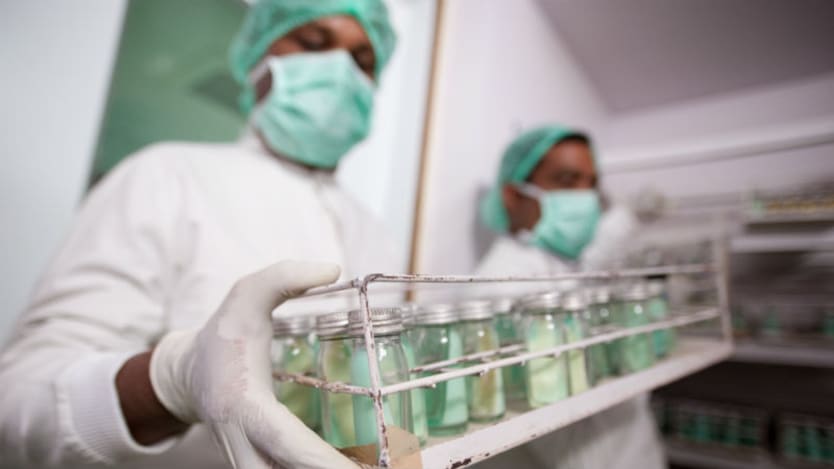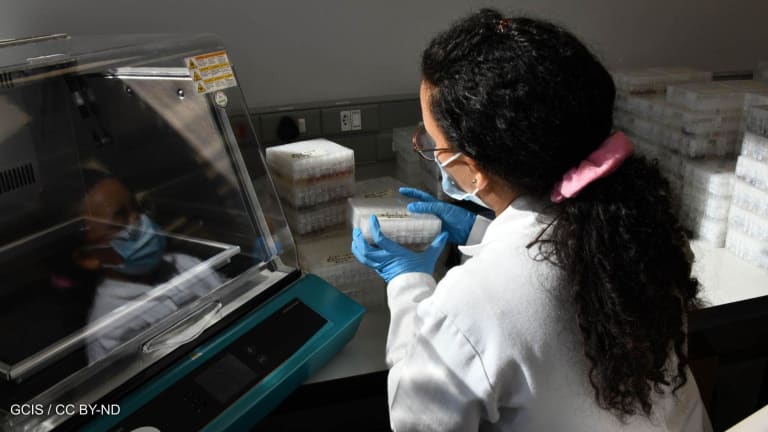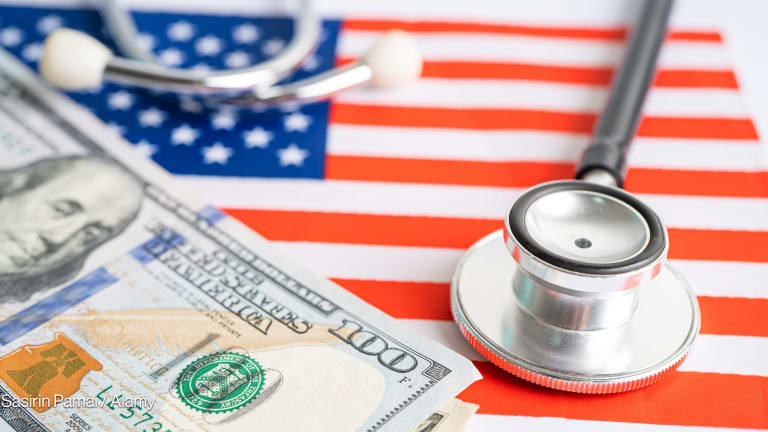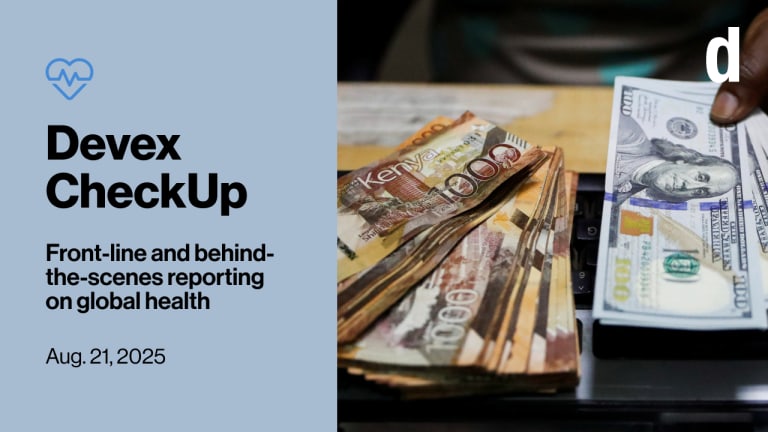
WASHINGTON, D.C. — Globalization means that the world is more interconnected than ever before. Travel between countries is faster and easier — as many as 8 million people travel by plane each day, according to the International Air Transport Association — and global supply chains allow food and medicine to be transported between countries in a matter of days. But while this growing interconnectedness is a great boon to businesses and economic growth, it also means that diseases can spread faster and more unpredictably than ever before. The threats of global pandemics are very real: According to World Bank President Jim Yong Kim, such threats represent by far the greatest global risk, with the potential to wipe out between 5 and 10 percent of the GDP of the world’s economy, as well as having the potential to kill tens of millions of people.
According to the European Commission’s Global Health Security Initiative the term “health security” is often used “to describe preparedness for and response to serious health incidents that are cross-border in nature and that pose a risk to security, destabilize economies, disrupt social cohesion, and affect the critical business of government.” Some of the risks to health security include chemical, biological, radiological and nuclear threats, and the spread of pandemic influenzas — for example, H1N1, or swine flu, in 2009 or, more recently, the Ebola outbreak in West Africa and the Zika epidemic in Brazil.
Climate-related natural disasters — including floods, earthquakes, and droughts — are another big risk to global health security. According to the U.N. Office for Disaster Risk Reduction, climate-related disasters alone have adversely affected the lives of 4.1 billion people over the past two decades and killed more than 600,000. The threats of epidemics after natural disasters are much higher, as survivors are often displaced into tightly populated refugee camps and access to safe water and latrines can be compromised.
That’s why so many high-level political, economic, and security leaders both at the national and international level are making the case that investing in global health and creating emergency funds and procedures to prevent, identify, and respond to emerging threats are so important. But what is at stake, and what are some key strategies and challenges related to building true global health security?
Strengthening national public health systems in developing countries
Opinion: No time to disarm — keeping up the global health security momentum
Since Ebola, the world has come together to ensure we are more prepared to stop outbreaks — but we are just beginning to reap the benefits of investments. As priorities shift and outbreaks disappear from the headlines, the U.S. and other countries must continue to invest in preparedness to ensure we are ready to respond to the next threat, writes PATH's Carolyn Reynolds in this op-ed.
The first step to preventing the next global pandemic is ensuring that all countries have robust and functioning public health systems that are capable of responding quickly to health risks. Unfortunately, this is far easier said than done. Countries that have historically been ground zero for global pandemics are often already struggling to address the routine health needs of their populations and lack the resources of higher-income countries. When a serious epidemic strikes, public health systems that lack adequate resources or preparation can run the risk of collapsing entirely.
“The question becomes, ‘How do we respond more rapidly in the early stages of an epidemic and ensure that countries with fragile health systems don’t end up accelerating the spread of disease?’” said Dr. Tom Inglesby, director of the Center for Health Security of the Johns Hopkins Bloomberg School of Public Health. “For example, with Ebola in West Africa many people went into the health care system sick with Ebola and either weren’t diagnosed or couldn’t be cared for safely, and so the disease propagated there.”
According to Dr. David Heymann, senior fellow of the Centre on Global Health Security at Chatham House, an international affairs think tank, any plan to deal with a potential health security crisis — whether an epidemic, pandemic, flood, earthquake, or act of biological terror — must have three core components: effective prevention, detection, and response. Surveillance systems are key to effective prevention and risk reduction, should be robust and responsive, and should be tapped into communities living in even the most rural areas, according to Heymann.
“The community has to be at the core of all responses; that’s part of what went wrong in the Ebola outbreak,” he said. “It’s vital to engage the community so they understand how they can participate in keeping an outbreak from spreading, like how to report that people are sick and how to do safe burials.”
An effective surveillance system should include periodic assessments of the health of animals living in proximity to humans, he said, which can prevent potential outbreaks by detecting sick animals before a disease has the opportunity to jump from animals to humans. Creating well-defined protocols, and ensuring that local health workers are trained on how to report potential outbreaks, is also critical.
Additionally, it’s vital to strengthen the capacities of governments and other stakeholders — including health ministries, hospitals, and health personnel — to respond to and contain infections. This is particularly important within the hospitals themselves, where sick people come to be treated.
“Ebola outbreaks wouldn’t have happened if hospitals had better infection control,” said Heymann. “There need to be protocols in place, and health workers should be trained on how to keep infections from spreading.”
Following the resolution of the Ebola epidemic in West Africa, more and more countries are beginning to prioritize domestic health security protocols.
Inglesby is optimistic about a consensus being reached.
“There is more interest in countries taking stock of their own capabilities, and more and more countries are working on this than probably there has been in a generation,” he said.
Strengthening international collaboration
Because health crises do not respect national boundaries, international collaboration is critical to creating a meaningful and effective health security strategy. Diverse stakeholders — including governments, international organizations such as the World Bank and World Health Organization, local health ministries, and health care workers, among others — have to work together to prepare protocols and to report and respond to threats. Doing this effectively, however, will require significant resources and increased coordination.
“One of the things that’s been really challenging in countering biological threats and pandemics is getting to the point that everyone is measuring using the same yardstick,” said Elizabeth Cameron, senior director for global biological policy and programs at the Nuclear Threat Initiative. “It was clear from the international health regulations that countries needed emergency operations capacity, workforce, good lab capacity, bio-safety and security. But there were no common metrics that countries could use to tell they were making strides toward this goal.”
In 2014 the Global Health Security Agenda was born out of this need for coordination and cooperation around key health security goals. Bringing together nearly 50 nations, international organizations, and nongovernmental stakeholders, GHSA aims to help participants strengthen their individual and collective capacities to detect, respond to and counter potential threats.
One of the most promising and innovative tools coming out of this collaboration is the Joint External Evaluation process, or JEE, a tool that emerged from the 2015 Global Health Security Agenda.
A peer-to-peer model, JEE is a voluntary, collaborative process in which outside experts examine and evaluate a country’s capacity to detect, prevent, and deal with potential threats over a period of two weeks, and assess different domains — for example, agricultural surveillance systems, laboratories, and public health responses — to identify potential weaknesses. Then, the JEE team helps the country to brainstorm solutions and engage with technical experts, partners and potential donors to address remaining gaps.
“The JEE has been truly valuable in giving countries a sense of where they are on the spectrum, and where they’d benefit from more work and international support,” said Inglesby, adding that in the future he’d like to see a collection of evidence-based reports on steps countries have taken to improve their capabilities, post-JEE.
“Right now stories are being told person-to-person, but there hasn’t been a systematic documentation of how the GHSA has been helping improve countries’ capabilities or how gaps identified in the JEE process are being filled,” he explained. “The more evidence-based information can be collected and circulated, the more other countries can see what is working and learn from one another.”
He would also like to see the creation of organized, international clinical teams that could be quickly deployed in big epidemics where needed to help support local health care systems and NGOs working on the ground.
Funding gaps
Financing is another critical issue. Global pandemics are not just a threat to public health, but also to the economic stability of countries and regional economies. While most African countries avoided major economic losses in the wake of the Ebola crisis, the impact on Guinea, Liberia, and Sierra Leone remains crippling. This impact not only reduces the ability of the governments of countries to respond quickly and effectively to the threats of new outbreaks, but also has long-term development implications. For example, the World Bank Group estimates that these three countries will lose at least $2.2 billion in forgone economic growth due to the crisis.
To prevent such economic devastation in the future, the institution has recently created a fund to provide emergency financing for epidemic response. While this is a step in the right direction, according to Inglesby, other innovative emergency financing mechanisms will also need to be developed.
Expanding the role of the private sector
Private companies also have a major role to play in the realm of global health security and can contribute in a number of ways, including optimizing supply chain management during emergencies, creating and distributing vaccines, and improving the accuracy and efficiency of surveillance systems.
According to Steve Davis, the president and CEO of international health organization PATH, one opportunity for private companies is in the optimization of countrywide surveillance systems, particularly those in the developing world. Currently, PATH is working closely with data and information providers to optimize the data analytics and data visualization of emergency response networks.
“A good surveillance system is not just about having data, but the ability to put that data together in order to recognize patterns and respond,” he said. “This is why we are working with various data visualization companies to find ways to improve these mechanisms for rapid diagnosis.”
One of their projects involves data mapping in the Democratic Republic of the Congo. Working closely with private companies, PATH draws on GPS data mapping tools that can help pinpoint places of infection in even the most remote areas.
“Eventually we will be able to use GPS tools to identify where and when to get to the most remote outbreak areas,” he said. “That will really be a breakthrough.”
Then there’s the manufacturing and distribution of vaccines in an emergency. To that end, the governments of Norway and India, the Bill & Melinda Gates Foundation, the Wellcome Trust and the World Economic Forum launched the Coalition for Epidemic Preparedness Innovations earlier this year. Known as CEPI, the coalition aims to work closely with private companies to ensure that vital vaccines that are generally underproduced, often due to a lack of economic incentives, are developed in adequate quantities to forestall the next epidemic. It also works with governments to find innovative financing solutions to ensure that immunization programs are implemented.
“There’s an awareness around global health security right now,” said Davis. “While the issues are multidimensional and complex, we know a lot of the things that we need to do, and how to get better prepared in terms of surveillance and good response mechanisms. The issue now is getting communities mobilized and following through on our commitments.”
Examining how global health affects security and vice versa, Devex, PATH, and Johnson & Johnson look at how country governments, donors, foundations, the private sector, and civil society can better respond and anticipate threats, asking whether increased investment in global health security is critical to the security of all countries. Join our conversation on preparing for the unexpected by visiting the From Healthy to Secure site and tagging #Health4Security and @Devex on social.








